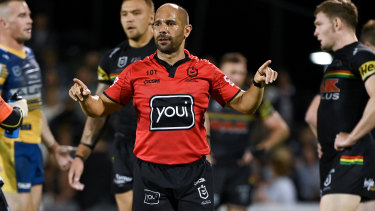More technology and rules? Awesome, just what rugby league needs
The NRL wants to put a computer chip in footballs so it can eradicate forward passes from the game … FOREVER!
Awesome.
Because that’s what rugby league needs: more complex technology layered on top of more complex rules heaping more complex questions on the browbeaten match officials.
Awesome.
The NRL’s constant changing and interpretation of rules has created a nightmare for officials.Credit:NRL Photos
NRL football boss Graham Annesley went public last week about trialling forward-pass technology, including the insertion of a micro-chip into the Steeden. How Terminator 3: Rise of the Machines.
It sounded suspiciously like the story I did with Annesley in 2017 when the NRL was trialling off-side technology, which the NRL thankfully never introduced because, presumably, it didn’t work.
“While I’m not sure of the outcome at this stage, the potential to finally crack one of the great frustrations of our game is very exciting,” Annesley said of finally ending the great forward-pass debate that nobody, from memory, has really being debating.
Dare I speak for the rugby league masses, but I’d suggest the truly great frustration of the game is the continual changing of the rules and the interpretation of them.
When are the people wearing the big pants at League Central going to realise that rugby league’s beauty is its simplicity, its free-flowing inclination that requires the match officials to play bit parts instead of leading roles?
Otherwise, you know game you’ve got? Rugby union. Eek!
NRL head of football Graham Annesley is a good man but needs to stop chasing perfection.Credit:NRL Photos
Annesley is a devout and hard-working administrator. He’s had to walk a fine line between what the ARL Commission wants and what the game needs. He’s become quite adept at toeing the company line.
He also takes calls from cranky coaches and headline-hunting journalists, all demanding answers that he can’t always give.
But he’s also a former referee seeking perfection in a game that is probably closer to life than any other sport; a perpetual hot mess that will never get its shit together. The sooner we all realise this the better our wretched lives will be.
Besides, why worry about groovy forward-pass technology when the game is mired in other hastily introduced rules and interpretations?
This season’s funky new rule is for referees to aw
ard penalties instead of tackle restarts inside an opposition’s 40-metre zone.
Awesome.
The fabled six-to-go rule for ruck infringements was introduced during the game’s shutdown from COVID-19 in the middle of 2020. It was supposed to eradicate the wrestle (which it didn’t) at the behest of broadcaster Channel Nine (which should never have a say in the rules of the game).
The distinction between the good teams and the bad became palpably clear. The new rules also suited some teams and not others, based on how they play the game and the players they had recruited.
If you didn’t have a nippy hooker and/or halfback, it was game over. Similarly, if your pack was too big and lacking ball-playing skill, you were just making up the numbers.
‘Over the years, it’s become evident that video technology answers some questions on a football field but raises just as many. By its very nature, it should only play a bit part in rugby league, nothing more.’
Instead of taking stock of this new rule, the NRL fuelled the fire with tackle restarts for offside in 2021. The game had gone from a dour wrestle in the middle to the park to touch footy in the space of two seasons.
The quality-coached teams backed their defence and gave away tackle restarts on the early tackles, giving their teammates time to set their line.
To combat this, the NRL has introduced penalties within an opposition’s 40m zone instead of restarts. It’s a rule change to fix the problems of a previous rule change.
Awesome.
Coaches I’ve spoken to are already laughing about it: strong defensive sides will give away set restarts anywhere on the field, including when defending their own line, because they back their defensive structures, especially against inferior opposition.
Much like the head high crackdown that lasted a month, this is policy on the run that changes the very fabric of the game.
At least the head high malarkey had good reason: the ARL Commission was petrified about litigation, so much so that if a player’s chest merely grazes the back of a ball-carrier’s neck it is deemed a “crusher tackle” and he can expect a two-match ban.
Eliminating these annoying vagaries should be at the top of Annesley’s to-do list instead of bothering with forward passes that have only become an issue in recent years because the referee spends so much time keeping an eye on everything else.
Referees appear to turn a blind eye to the litany of forward passes thrown from dummy half while pulling up any flat, crisp cut-out pass that thumps into the chest of the winger.
Those passes forged the legends of Lewis, Stuart, Johns, Fittler and other quality playmakers. Now the whistleblowers and linespeople pull them back with regular monotony.
Do they really need micro-chip technology to tell them what’s forward and what’s not?
There’s a quote from supercoach Jack Gibson written in uppercase on the wall just outside the NRL Bunker in Eveleigh.
“THE USE OF VIDEO EVIDENCE IS NOT ALWAYS CONCLUSIVE BUT IT SURE BEATS THE MEMORY BANK OF MOST WITNESSES.”
Over the years, it’s become evident that video technology answers some questions on a football field but raises just as many. By its very nature, it should only play a bit part in rugby league, nothing more.
The game needs less interference from the match officials — on the field and definitely in the stands or bunker — so we can focus on the real stars of the show.
(The players, just to clarify).
Sports news, results and expert commentary. Sign up for our Sport newsletter.
Most Viewed in Sport
From our partners
Source: Read Full Article


